Trafalgar Square
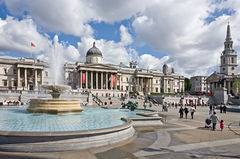 Trafalgar Square, Westminster |
|
| Type | Square |
|---|---|
| Managed by | Greater London Authority |
| Country | England |
| Region | London |
| UK Grid square | TQ299804 |
| Address | City of Westminster, London |
| Postcode | WC2 |
| Website | www.london.gov.uk/trafalgarsquare/ |
Trafalgar Square is a square in central London, England. With its position in the heart of London, it is a tourist attraction, and one of the most famous squares in the United Kingdom and the world. At its centre is Nelson's Column, which is guarded by four lion statues at its base. Statues and sculptures are on display in the square, including a fourth plinth displaying changing pieces of contemporary art. The square is also used as a location for political demonstrations and community gatherings, such as the celebration of New Year's Eve in London.
The name commemorates the Battle of Trafalgar (1805), a British naval victory of the Napoleonic Wars. The original name was to have been "King William the Fourth's Square", but George Ledwell Taylor suggested the name "Trafalgar Square".
The northern area of the square had been the site of the King's Mews since the time of Edward I, while the southern end was the original Charing Cross, where the Strand from the City met Whitehall, coming north from Westminster. As the midpoint between these twin cities, Charing Cross is to this day considered the heart of London, from which all distances are measured.
In the 1820s the Prince Regent engaged the landscape architect John Nash to redevelop the area. Nash cleared the square as part of his Charing Cross Improvement Scheme. The present architecture of the square is due to Sir Charles Barry and was completed in 1845.
Trafalgar Square is owned by the Queen in Right of the Crown, and managed by the Greater London Authority.[1]
Contents |
Overview
The square consists of a large central area surrounded by roadways on three sides, and stairs leading to the National Gallery on the other. The roads which cross the square form part of the A4 road, and prior to 2003, the square was surrounded by a one-way traffic system. Underpasses attached to Charing Cross tube station allow pedestrians to avoid traffic. Recent works have reduced the width of the roads and closed the northern side of the square to traffic.
Nelson's Column is in the centre of the square, surrounded by fountains designed by Sir Edwin Lutyens in 1939 (replacing two earlier fountains of Peterhead granite, now at the Wascana Centre and Confederation Park in Canada) and four huge bronze lions sculpted by Sir Edwin Landseer. Cast by the Morris Singer Foundry, the metal used is said to have been recycled from the cannon of the French fleet. The column is topped by a statue of Horatio Nelson, the vice admiral (or Admiral in the White) who commanded the British Fleet at Trafalgar.
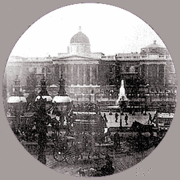
The fountains are memorials to Lord Jellicoe (western side) and Lord Beatty (eastern side), Jellicoe being the Senior Officer.[2]
On the north side of the square is the National Gallery and to its east St Martin-in-the-Fields church. The square adjoins The Mall via Admiralty Arch to the southwest. To the south is Whitehall, to the east Strand and South Africa House, to the north Charing Cross Road and on the west side Canada House.
At the corners of the square are four plinths; the two northern ones were intended for equestrian statues, and thus are wider than the two southern. Three of them hold statues: George IV (northeast, 1840s), Henry Havelock (southeast, 1861, by William Behnes), and Sir Charles James Napier (southwest, 1855). Former Mayor of London Ken Livingstone controversially expressed a desire to see the two generals replaced with statues "ordinary Londoners would know".[3]
On the lawn in front of the National Gallery are two statues, James II to the west of the entrance portico and George Washington to the east. The latter statue, a gift from the state of Virginia, stands on soil imported from the United States. This was done in order to honour Washington's declaration he would never again set foot on British soil.[4]
In 1888 the statue of General Charles George Gordon was erected. In 1943 the statue was removed and, in 1953, re-sited on the Victoria Embankment. A bust of the Second World War First Sea Lord Admiral Cunningham by Franta Belsky was unveiled in Trafalgar Square on 2 April 1967 by Prince Philip, Duke of Edinburgh.[5]
The square has become a social and political location for visitors and Londoners alike, developing over its history from "an esplanade peopled with figures of national heroes, into the country’s foremost place politique", as historian Rodney Mace has written. Its symbolic importance was demonstrated in 1940 when the Nazi SS developed secret plans to transfer Nelson's Column to Berlin following an expected German invasion, as related by Norman Longmate in If Britain Had Fallen (1972).


Features
Fourth plinth
The fourth plinth on the northwest corner, designed by Sir Charles Barry and built in 1841,[6] was intended to hold an equestrian statue of William IV, but remained empty due to insufficient funds.[7] A statue of Edward Jenner, funded largely by public subscription, was unveiled on the fourth plinth in 1858, but protests by anti-vaccinationists led to its removal to Kensington Gardens four years later.[8] Later, agreement could not be reached over which monarch or military hero to place there.
In 1999, the Royal Society of Arts (RSA) conceived the Fourth Plinth Project, which temporarily occupied the plinth with a succession of works commissioned from three contemporary artists. These were:
- Mark Wallinger: Ecce Homo (1999) – Wallinger's Ecce Homo – the Latin title of which means "Behold the man", a reference to the words of Pontius Pilate at the trial of Jesus Christ (John 19:5) – was a life-sized figure of Christ, naked apart from a loin cloth, with his hands bound behind his back and wearing a crown of barbed wire (in allusion to the crown of thorns). Atop the huge plinth, designed for larger-than-life statuary, it looked minuscule. Some commentators said that, far from making the Man look insignificant, his apparent tininess drew the eye powerfully; they interpreted it as a commentary on human delusions of grandeur.[9]
- Bill Woodrow: Regardless of History (2000)[10]
- Rachel Whiteread: Monument (2001) – Whiteread's Monument, by an artist already notable for her controversial Turner Prize-winning work House and the Judenplatz Holocaust Memorial in Vienna, was a cast of the plinth in transparent resin placed upside-down on top of the original.[11]
Companies have used the plinth (often without permission) as a platform for publicity stunts, including a model of David Beckham by Madame Tussauds during the 2002 FIFA World Cup.[6] The London-based American harmonica player Larry Adler jokingly suggested erecting a statue of Moby-Dick, which would then be called the "Plinth of Whales".[12] A television ident for the British TV station Channel 4 shows a CGI Channel 4 logo on top of the fourth plinth.[13]
The best use of the fourth plinth remains the subject of debate. On 24 March 2003 an appeal was launched by Wendy Woods, the widow of the anti-apartheid journalist Donald Woods, hoping to raise £400,000 to pay for a nine-foot high statue of Nelson Mandela by Ian Walters.[14] The relevance of the location is that South Africa House, the South African high commission, scene of many anti-apartheid demonstrations, is on the east side of Trafalgar Square.
A committee convened to consider the RSA's late-1990s project concluded that it had been a success and "unanimously recommended that the plinth should continue to be used for an ongoing series of temporary works of art commissioned from leading national and international artists".[15] After several years in which the plinth stood empty, the new Greater London Authority assumed responsibility for the fourth plinth and started its own series of changing exhibitions:
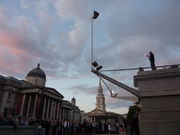
- Marc Quinn: Alison Lapper Pregnant (unveiled 15 September 2005) – a 3.6-metre, 13-tonne[6] marble torso-bust of Alison Lapper, an artist who was born with no arms and shortened legs due to a condition called phocomelia.[16]
- Thomas Schütte: Model for a Hotel 2007 (formerly Hotel for the Birds) (unveiled 7 November 2007) – a 5-metre by 4.5-metre by 5-metre architectural model of a 21-storey building made from coloured glass. The work cost £270,000 and was funded primarily by the Mayor of London and the Arts Council of England. Sandy Nairne, director of the National Portrait Gallery and chairman of the Fourth Plinth Commissioning Group that recommended Quinn's and Schütte's proposals to the Mayor in 2004, said: "There will be something extraordinarily sensual about the play of light through the coloured glass ... [I]t's going to feel like a sculpture of brilliance and light."[6][17]
- Antony Gormley: One & Other (6 July – 14 October 2009) – over the course of a hundred consecutive days, a total of 2,400 selected members of the public each spent one hour on the plinth. They were allowed to do anything they wished to and could take anything with them that they could carry unaided. Volunteers for the Fourth Plinth were invited to apply through the website www.oneandother.co.uk, and were chosen so that ethnic minorities and people from all parts of Britain were represented. For safety reasons, the plinth was surrounded by a net, and a team of six stewards were present 24 hours a day to make sure that, for instance, participants were not harmed by hecklers. There was a live feed of the plinth on the Internet sponsored by TV channel Sky Arts.[18][19] Gormley said: "In the context of Trafalgar Square with its military, valedictory and male historical statues, this elevation of everyday life to the position formerly occupied by monumental art allows us to reflect on the diversity, vulnerability and particularity of the individual in contemporary society. It's about people coming together to do something extraordinary and unpredictable. It could be tragic but it could also be funny."[19]
- Yinka Shonibare: Nelson's Ship in a Bottle (24 May 2010 – present) – this work, by a leading Anglo-Nigerian artist, consists of a replica of Nelson's ship, the HMS Victory, with sails made of printed fabric in a colourful African pattern inside a large glass bottle stopped with a cork. According to the Greater London Authority, the artwork is the first "to reflect specifically on the historical symbolism of Trafalgar Square, which commemorates the Battle of Trafalgar, and will link directly with Nelson's column. It is also the first commission by a black British artist."[20]
In February 2008, Terry Smith, the chief executive of trading house Tullett Prebon, offered to pay more than £100,000 for a permanent statue acceptable to "ordinary Londoners" of Air Chief Marshal Sir Keith Park in recognition of his work as commander of No. 11 Group RAF during the Battle of Britain, as it was this Group that was responsible for the defence of London. A Greater London Authority spokesman said: "There are many worthy suggestions for statues on the fourth plinth and some people feel passionately about each of them. All proposals will be judged on their merits including its current use as one of the most high profile sites for contemporary public art in London. The cost of erecting the current work on the plinth is £270,000. The cost of a permanent monument is likely to be considerably more."[21] Subsequently, it was announced in May 2009 that in autumn that year a 5-metre high fibreglass statue of Sir Keith would be placed on the fourth plinth for six months, with a 2.78-metre bronze statue permanently installed in Waterloo Place.[22]
Fountains
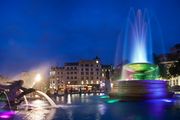
When the square was first built in 1845, the fountains' primary purpose was not aesthetics, but rather to reduce the open space available and the risk of riotous assembly. They were originally fed by a steam engine behind the National Gallery from an artesian well underground. However, the engine were generally considered to be underpowered, so in the late 1930s the decision was made to replace them with stone basins and a new pump. At a cost of almost £50,000, the fountains were replaced with a design by Sir Edwin Lutyens and the old fountains were sold to donors and became gifts to Canada, eventually installed in Ottawa and Regina, where they are still in use today.[23][24] The Lutyens design is now listed Grade II.
Further restoration work became necessary and was completed by May 2009. The pump system was replaced as only one of three pumps was functioning. The new pump is capable of sending an 80-foot (24 m) jet of water into the air.[25] A new LED lighting system was also installed during this restoration to reduce the cost of lighting maintenance as the old incandescent bulbs cost £1,000 to replace and were failing regularly. The new lighting has been designed with the London 2012 Summer Olympics in mind and for the first time will project many different combinations of colours on to the fountains.[23] In addition, the new lighting system has a much lower energy requirement and will reduce the carbon footprint of the lighting by around 90%.[25]
Pigeons
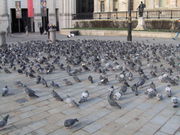
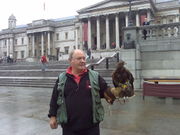
The square is famous for its feral pigeons, and feeding them is a popular activity with Londoners and tourists. The National Portrait Gallery displays a 1948 photograph of Elizabeth Taylor posing there with bird seed so as to be mobbed by birds. The desirability of the birds' presence has long been contentious: their droppings look ugly on buildings and damage the stonework, and the flock, estimated at its peak to be 35,000, was considered to be a health hazard. In 1996, police arrested one man who was estimated to have trapped 1,500 birds for sale to a middleman; it is assumed that the birds were being trapped to be eaten.
In 2000, the sale of bird seed in the square was controversially terminated and other measures were introduced to discourage the pigeons, including the use of trained falcons. Supporters of the birds – including Save the Trafalgar Square Pigeons – as well as some tourists continued to feed the birds, but in 2003 the then-Mayor, Ken Livingstone, enacted byelaws to ban the feeding of pigeons within the square.[26] Due to frequent circumvention of these byelaws, on 10 September 2007 further byelaws were passed by the Westminster City Council to ban the feeding of birds on the square's pedestrianised North Terrace, the entire perimeter of the square, the area around St Martin-in-the-Fields Church, the space directly in front of the National Gallery, Canada House, South Africa House and parts of The Mall, Charing Cross Road and The Strand.[27] There are now few birds in Trafalgar Square and it is used for festivals and hired out to film companies in a way that was not feasible in the 1990s.
Redevelopment
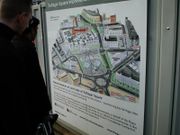
In 2003 the redevelopment of the north side of the square was completed. The work involved permanently closing the main eastbound road there – diverting it around the rest of the square and demolishing part of the wall and building a wide set of stairs. This construction includes two Saxon scissor lifts for disabled access, public toilets, and a small café. Plans for a large staircase had long been discussed, even in original plans for the square. The new stairs lead to a large terrace or piazza in front of the National Gallery, in what was previously a road. Previously access between the square and the Gallery was via two busy crossings at the north east and north west corners of the square. The pedestrianisation plan was carried out in the face of protests from both road-users and pedestrians concerned that the diversion of traffic would lead to greater congestion elsewhere in London. However, this does not seem to have happened; the reduction in traffic due to the London congestion charge may be a factor.
Uses
New Year events
For many years, revellers celebrating the start of a New Year have gathered on the square, despite a lack of civic celebrations being arranged for them. The lack of official events in the square was partly because the authorities were concerned that actively encouraging more partygoers would cause overcrowding.
Since 2005, a firework display centred on London Eye and the South Bank of the Thames near the Square has given spectators a fitting start to the New Year.
VE Day celebrations
Victory in Europe Day (VE Day) was 8 May 1945, the date when the Allies during the Second World War formally celebrated the defeat of Nazi Germany and the end of Adolf Hitler's Third Reich. Trafalgar Square was filled with British subjects wanting to hear the formal announcement by Sir Winston Churchill that the war was over. Trafalgar Square was also used as a place of celebration by people travelling there from all over the country. On 8 May 2005 the BBC held a concert hosted by Eamonn Holmes and Natasha Kaplinsky to celebrate the 60th anniversary of VE Day.
Christmas ceremony

There has been a Christmas ceremony at Trafalgar Square every year since 1947. A Norway Spruce (or sometimes a fir) is given by Norway's capital Oslo and presented as London's Christmas tree, as a token of gratitude for Britain's support during World War II. (Besides the general war support, Norway's Prince Olav, as well as the country's government, lived in exile in London throughout the war.) As part of the tradition, the Lord Mayor of Westminster visits Oslo in the late autumn to take part in the felling of the tree, and the Mayor of Oslo then comes to London to light the tree at the Christmas ceremony.[28]
Political demonstrations
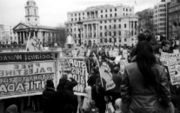

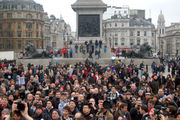
Since its construction, Trafalgar Square has been a venue for political demonstrations, though the authorities have often attempted to ban them. The 1939 fountains were allegedly added on their current scale to reduce the possibility of crowds gathering in the square as they were not in the original plans.
By March of the year Nelson's column opened, the authorities had started banning Chartist meetings in the square. A general ban on political rallies remained in effect until the 1880s, when the emerging Labour movement, particularly the Social Democratic Federation, began holding protests there.
On "Black Monday" (8 February 1886), protesters rallied against unemployment; this led to a riot in Pall Mall. A larger riot (called "Bloody Sunday") occurred in the square on 13 November 1887.
One of the first significant demonstrations of the modern era was held in the square on 19 September 1961 by the Committee of 100, which included the philosopher Bertrand Russell. The protesters rallied for peace and against war and nuclear weapons.
Throughout the 1980s, a continuous anti-apartheid protest was held outside South Africa House. More recently, the square has hosted the Poll Tax Riots (1990) and anti-war demonstrations opposing the Afghanistan war and the Iraq war.[29]
The square was also scene to a large vigil held shortly after the terrorist bombings in London on Thursday, 7 July 2005.[30]
In December 2009, participants from the Camp for Climate Action occupied the square for the two weeks in which the UN Conference on Climate Change took place in Copenhagen[31]. It was billed as a UK base for direct action on climate change during the conference, and saw various actions and protests stem from the occupation[32][33][34].
Sports events
On 21 June 2002, 12,000 people gathered in the square to watch the England national football team's World Cup quarter-final against Brazil on giant video screens which had been erected specially for the occasion.[35]
In the early 21st century, Trafalgar Square has become the location to the climax for victory parades. It was used by the England national rugby union team on 9 December 2003 to celebrate its victory in the 2003 Rugby World Cup, and then on 13 September 2005 for the England national cricket team's victory against the Australia national cricket team in The Ashes.
On 6 July 2005 Trafalgar Square was a gathering place to hear the announcement that London had won the bid to host the 2012 Summer Olympics.
In 2007, Trafalgar Square hosted the opening ceremonies of the Tour de France.
Other uses
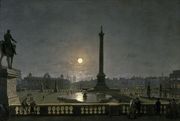
Trafalgar Square is popularly used in films to suggest a generic London location (as an alternative to Big Ben) or less frequently, Britain in general. It featured prominently in films and television during the Swinging London era of the late 1960s, including The Avengers, Casino Royale, Doctor Who, The Ipcress File and Man in a Suitcase.
Trafalgar Square was used for portions of two sketches from the BBC comedy series Monty Python's Flying Circus. In a continuation of the sketch Collecting Birdwatchers' Eggs, several people in tan trenchcoats wander around the square mocking the famous pigeons. The sketch Olympic Hide and Seek also starts here. This sketch features Graham Chapman as British contestant Don Roberts and Terry Jones as Francisco Huron, his competitor from Paraguay in a contest that ends in a tie after more than 11 years. Chapman catches a taxi near the base of Lord Nelson's Column at the beginning of the sketch. Trafalgar Square also appears in cartoon form in several of Terry Gilliam's animations.
Trafalgar Square is also featured in the comic version of V for Vendetta as the location that the V's meet the army and defeat them, without a single fired shot due to sheer numbers (and the work of the Original V).
Trafalgar Square was used for a chess tournament in both London and Moscow, where the pieces and pawns were made out of ice, some resembling landmarks from both cities.
The square was also the location of the successful "World's Largest Coconut Orchestra" world record attempt on 23 April 2007. The record was set on St George's Day, and was followed by a screening of Monty Python and the Holy Grail. The world record attempt was linked with the use of coconuts during the film as well as the stage show Spamalot.
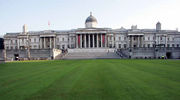
In May 2007, the square was grassed over with 2,000 square metres of turf for two days as part of a campaign by London authorities to promote "green spaces" in the city.[37]
In July 2007, the square held a parade and concert for the 60th independence of Pakistan from Great Britain. The event included many legendary sports and celebrity performances and many exhibitions of Pakistan's heritage and culture. It was recorded to be the biggest gathering of expat Pakistanis in the whole of Europe. It was televised live with Geo TV, a private Pakistani television and the High Commission of Pakistan.
Every year on the anniversary of the Battle of Trafalgar (21 October), the Sea Cadet Corps holds a parade in honour of Admiral Lord Nelson and the British victory over the combined fleets of Spain and France at Trafalgar. The Areas of the Sea Cadet Corps are represented by seven 24-cadet platoons, made up of 12 male and 12 female cadets. They represent the Eastern Area, London Area, Southern Area, Southwest Area, Northwest Area, Northern Area and Marine Cadets. The National Sea Cadet Band also parades, as does a Guard and Colour Party.
On 30 April 2009, an estimated 13,500 people visited the square between 6:00 and 7:00 pm to a mass sing-a-long, organised by telephone company T-Mobile, to co-opt individuals as part of a commercial advertisement.
The day after Michael Jackson's death, crowds gathered at Trafalgar Square.
Gallery
 South Africa House, in the east |
 Canada House |
 Trafalgar Square, July 2006 |
 Trafalgar Square, July 2006 |
|
Trafalgar Square, including Nelson's Column looking south towards the Houses of Parliament. |
A central view of Trafalgar Square, centring on Nelson's Column, from the steps of the National Gallery. |
Access
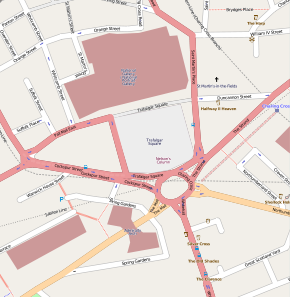
Nearest London Underground stations:
- Charing Cross - Northern and Bakerloo Lines — has an exit in the square. The two lines originally had separate stations, of which the Bakerloo Line one was called Trafalgar Square; they were linked and renamed in 1979 as part of the construction of the Jubilee Line, which was later rerouted elsewhere.
- Embankment - District, Circle, Northern and Bakerloo Lines.
- Leicester Square - Northern and Piccadilly lines
Bus routes running through Trafalgar Square:
- 6, 9, 11, 12, 13, 15, 23, 24, 29, 53, 87, 88, 91, 139, 159, 176, 453.
Other Trafalgar Squares
National Heroes Square in Bridgetown, Barbados, was originally named Trafalgar Square in 1813, before the better known British thoroughfare, with another statue of Admiral Horatio Nelson featured. The name change occurred on 28 April 1999.
There is also a Trafalgar Square in Barre, Massachusetts.[38]
The suburb of Waterloo in the city of Lower Hutt, New Zealand, features a Trafalgar Square opposite the Waterloo Interchange Railway Station, a major metropolitan hub.[39]
See also
- Canada House
- Parliament Square
- South Africa House
Notes
- ↑ http://hansard.millbanksystems.com/written_answers/2003/nov/27/trafalgar-square
- ↑ G[eorge] H[enry] Gater; F[rederick] R[obert] Hiorns (1940), Trafalgar Square and Neighbourhood (Survey of London. vol. 20. The Parish of St. Martin-in-the-Fields. pt. 3.), London: London County Council, https://www.british-history.ac.uk/report.aspx?compid=68408, retrieved 16 October 2008.
- ↑ Paul Kelso (20 October 2000), "Mayor attacks generals in battle of Trafalgar Square", The Guardian (London), http://www.guardian.co.uk/uk_news/story/0,3604,385413,00.html, retrieved 25 May 2007.
- ↑ 10 famous London statues, http://travel.msn.com/Guides/article.aspx?cp-documentid=345328&page=2, retrieved 18 June 2007.
- ↑ Bust of Viscount Cunningham of Hyndhope by Franta Belsky, Your Archives, The National Archives, http://yourarchives.nationalarchives.gov.uk/index.php?title=Bust_of_Viscount_Cunningham_of_Hyndhope_by_Franta_Belsky, retrieved 27 November 2007.
- ↑ 6.0 6.1 6.2 6.3 Alastair Sooke (3 November 2007), "Art versus the pigeons", The Daily Telegraph (Review) (London): 4, http://www.telegraph.co.uk/arts/main.jhtml?xml=/arts/2007/11/03/baplinth103.xml.
- ↑ David Doyle (18 June 2007), Arthur's design proves eye-catching, Ealing Times, http://www.ealingtimes.co.uk/news/localnews/display.var.1479441.0.arthurs_design_proves_eyecatching.php, retrieved 30 May 2008.
- ↑ Gareth Williams (2010), "Put Edward Jenner's statue back in Trafalgar Square", British Medical Journal 340: c1582, doi:10.1136/bmj.c1582, PMID 20338943.
- ↑ See also You'll either love it or hate it, BBC News, 23 July 1999; Maev Kennedy (13 May 2000), "Modern art wins battle of Trafalgar Square: Vacant plinth will be showcase for contemporary sculpture", The Guardian (London), http://www.guardian.co.uk/culture/2000/may/13/artsfeatures1; Oliver Marre (11 May 2008), "The artist gets back in the saddle: The Turner Prize-winner Mark Wallinger has never been afraid of courting criticism. His latest project, a return to one of his favourite themes, could be his most controversial statement yet: a 164ft-high white stallion in Kent", The Observer (London), http://www.guardian.co.uk/artanddesign/2008/may/11/art.news4.
- ↑ For photographs of Bill Woodrow's Regardless of History, see Bill Woodrow, Regardless of History, 2000, Cass Sculpture Foundation, http://www.sculpture.org.uk/work/000000100153, retrieved 12 February 2008.
- ↑ For a maquette one-tenth the size of the original sculpture, see Rachel Whiteread, Maquette for Monument, 1999, Cass Sculpture Foundation, 1999?, http://www.sculpture.org.uk/work/000000100159, retrieved 12 February 2008.
- ↑ Warren Hoge (19 August 1999), "London Journal: Plinth seeks occupant. Nelson will be neighbor", The New York Times, http://www.nytimes.com/1999/08/19/world/london-journal-plinth-seeks-occupant-nelson-will-be-neighbor.html.
- ↑ Channel 4 television ident.
- ↑ James Macintyre (7 August 2008), "From Beckham to Lapper, the ever-changing cast", The Independent (London), http://www.independent.co.uk/arts-entertainment/art/news/from-beckham-to-lapper-the-everchanging-cast-887463.html.
- ↑ (PDF) Fourth Plinth Secondary Schools Award: How will your students be inspired by the Fourth Plinth?, London: Greater London Authority, August 2007, p. 5, http://www.fourthplinth.co.uk/docs/fourth-plinth-secondary-pack.pdf.
- ↑ Square's naked sculpture revealed, BBC News, 19 September 2005, http://news.bbc.co.uk/1/hi/england/london/4247000.stm.
- ↑ See also Rachel Cooke (4 November 2007), "Check into Trafalgar Square's new hip hotel", The Observer (London), http://arts.guardian.co.uk/art/visualart/story/0,,2204825,00.html; Charlotte Higgins (8 November 2007), "Trafalgar Square sculpture unveiled", The Guardian (London), http://arts.guardian.co.uk/art/news/story/0,,2206983,00.html; Adrian Searle (8 November 2007), "'It is like a jewel'", The Guardian (g2) (London), http://arts.guardian.co.uk/art/visualart/story/0,,2207206,00.html.
- ↑ Alastair Sooke (28 February 2009), "Fancy turning yourself into a work of art?: Sculptor Antony Gormley is giving 2,400 people the chance to spend an hour alone on the Trafalgar Square plinth", The Daily Telegraph (Review) (London): 10–11, http://www.telegraph.co.uk/culture/4838343/Antony-Gormleys-Fourth-Plinth-Trafalgar-Square.html.
- ↑ 19.0 19.1 "Trafalgar Square fourth plinth art 'will cause arrests': The artist Antony Gormley, who is behind the new work for Trafalgar Square's empty fourth plinth, has said he expected the piece to lead to arrests", The Daily Telegraph (London), 26 February 2009, http://www.telegraph.co.uk/culture/culturenews/4840197/Trafalgar-Square-fourth-plinth-art-will-cause-arrests.html, retrieved 25 May 2010.
- ↑ The Fourth Plinth: Nelson's Ship in a Bottle, Greater London Authority, 2010, archived from the original on 2 September 2010, http://www.webcitation.org/5sR2wMdfe, retrieved 2 September 2010. See also Yinka Shonibare's ship docks on the fourth plinth: The making and unveiling of Nelson's Ship in a Bottle, the latest art work to occupy the much-coveted spot in Trafalgar Square, Guardian.co.uk, 25 May 2010, http://www.guardian.co.uk/artanddesign/video/2010/may/25/yinka-shonibar-fourth-plinth
- ↑ Thomas Harding (26 February 2008), "City boss calls for statue of war hero", The Daily Telegraph (London), http://www.telegraph.co.uk/news/main.jhtml?xml=/news/2008/02/25/nhero125.xml.
- ↑ "Battle of Britain hero statue will stand in Trafalgar Square: Battle of Britain hero Sir Keith Park will be honoured with the erection of two statues", The Daily Telegraph (London), 8 May 2009, http://www.telegraph.co.uk/news/uknews/5293761/Battle-of-Britain-hero-statue-will-stand-in-Trafalgar-Square.html, retrieved 25 May 2010.
- ↑ 23.0 23.1 Kennedy, Maev (29 May 2009), "Trafalgar Square fountain spurts to new heights", The Guardian (London), http://www.guardian.co.uk/uk/2009/may/29/trafalgar-square-fountains-reopen, retrieved 25 May 2010.
- ↑ "Trafalgar Square fountains", http://www.garden-fountain.co.uk/trafalgar.asp, 2003, http://www.garden-fountain.co.uk/trafalgar.asp, retrieved 16 July 2009.
- ↑ 25.0 25.1 "Trafalgar Square fountains cascade in colour for 2012", Evening Standard, 29 May 2009, http://www.thisislondon.co.uk/standard/article-23701248-details/Trafalgar+Square+fountains+cascade+in+colour+for+2012/article.do.
- ↑ Trafalgar Square byelaws, London.gov.uk, 17 September 2007, http://www.london.gov.uk/trafalgarsquare/manage/byelaws.jsp, retrieved 8 November 2007.
- ↑ Pigeon feeding banned in Trafalgar Square, 24dash.com, 10 September 2007, http://www.24dash.com/localgovernment/27299.htm, retrieved 17 September 2007.
- ↑ "Lieutenant 'Polly' Perkins: Motor torpedo boat captain awarded two DSCs who used an operation in Norway to harvest Christmas trees [obituary]", The Daily Telegraph (London), 16 Jun 2008, http://www.telegraph.co.uk/news/obituaries/2140985/Lieutenant-Polly-Perkins.html, retrieved 25 May 2010.
- ↑ Keith Flett (8 January 2005), "The Committee of 100: Sparking a new left", Socialist Worker (1933), http://www.socialistworker.co.uk/article.php?article_id=5114.
- ↑ London falls silent for bomb dead, BBC News, 14 July 2005, http://news.bbc.co.uk/1/hi/uk/4679681.stm.
- ↑ http://www.climatecamp.org.uk/actions/copenhagen-2009/cop15-out
- ↑ http://www.indymedia.org.uk/en/2009/12/443493.html?c=on#c239066
- ↑ http://www.indymedia.org.uk/en/2009/12/443706.html
- ↑ http://www.indymedia.org.uk/en/2009/12/443698.html
- ↑ England fans mourn defeat, BBC News, 21 June 2002, http://news.bbc.co.uk/sport3/worldcup2002/hi/matches_wallchart/england_v_brazil/newsid_2055000/2055509.stm.
- ↑ Hood, J. (2005). Trafalgar Square: A Visual History Of London's Landmark Through Time, p54
- ↑ Trafalgar Square green with turf, BBC News, 24 May 2007, http://news.bbc.co.uk/1/hi/england/london/6687089.stm.
- ↑ See, for instance, Bradford L. Miner (2 March 2007), "Pine creaks no more; Woman's worries addressed", Telegram & Gazette (reproduced on HighBeam Encyclopedia), http://www.encyclopedia.com/doc/1G1-160497045.html: "With a wintry mix of freezing rain, sleet, snow and wind forecast for today, Mary Jane Bade of 18 Trafalgar Square, South Barre, was more fearful than ever of what might happen if the damaged, towering white pine in her backyard were to come down during the storm"; and James F. Russell (12 July 2007), "Water system funds flow elsewhere: New administrator, same result on 3rd try in block grant competition", Telegram & Gazette, http://www.telegram.com/article/20070712/NEWS/707120528/1004/RSS01&source=rss: "Barre officials have said the grant would have been used to pay for water main, hydrant and service connection replacement along High Plains, Trafalgar Square, Celona Square and the Vernon Avenue districts in South Barre". A map of the location can be viewed at Trafalgar Square, Barre, MA 01005, Google Maps, 2008, http://maps.google.com/maps?q=Trafalgar+Square,+Barre,+MA,+USA&sa=X&oi=map&ct=title, retrieved 6 June 2008.
- ↑ Trafalgar Square, Waterloo, 5011 New Zealand, Google Maps, 2008, http://maps.google.co.uk/maps?hl=en&q=%2B%22trafalgar+square%22+%2B%22lower+hutt%22&um=1&ie=UTF-8&sa=X&oi=geocode_result&resnum=1&ct=title, retrieved 26 June 2008.
Further reading
Articles
- Takkides, Stephan (12 February 2007), Fourth Plinth, Location: City of Westminster, blitzandblight.com, http://www.blitzandblight.com/fourth-plinth, retrieved 12 February 2008.
Books
- Hargreaves, Roger (2005), Trafalgar Square: Through the Camera, London: National Portrait Gallery Publications, ISBN 1855143453
- Holt, Gavin (1934), Trafalgar Square, London: Hodder & Stoughton
- Hood, Jean (2005), Trafalgar Square: A Visual History of London’s Landmark through Time, London: Batsford, ISBN 0713489677 (hbk.)
- Mace, Rodney (1976), Trafalgar Square: Emblem of Empire, London: Lawrence and Wishart, ISBN 085315368X Second edition published as Mace, Rodney (2005), Trafalgar Square: Emblem of Empire (2nd ed.), London: Lawrence and Wishart, ISBN 1905007116 (pbk.)
External links
General
- Official website of Trafalgar Square on the Mayor of London's website
- iOn The Square – guide to Trafalgar Square
- Trafalgar Square Flickr photo pool
- Trafalgar Square webcam from Camvista.com
- London Landscape TV episode (5 mins) about Trafalgar Square
- [1] – Fourth Plinth charity balloon race
Fourth plinth
- Fourth plinth project
- Sir Keith Park Memorial Campaign – proposal to erect a statue in honour of the Battle of Britain war hero Air Chief Marshal Sir Keith Park
|
|||||||||||||||||||||||||
